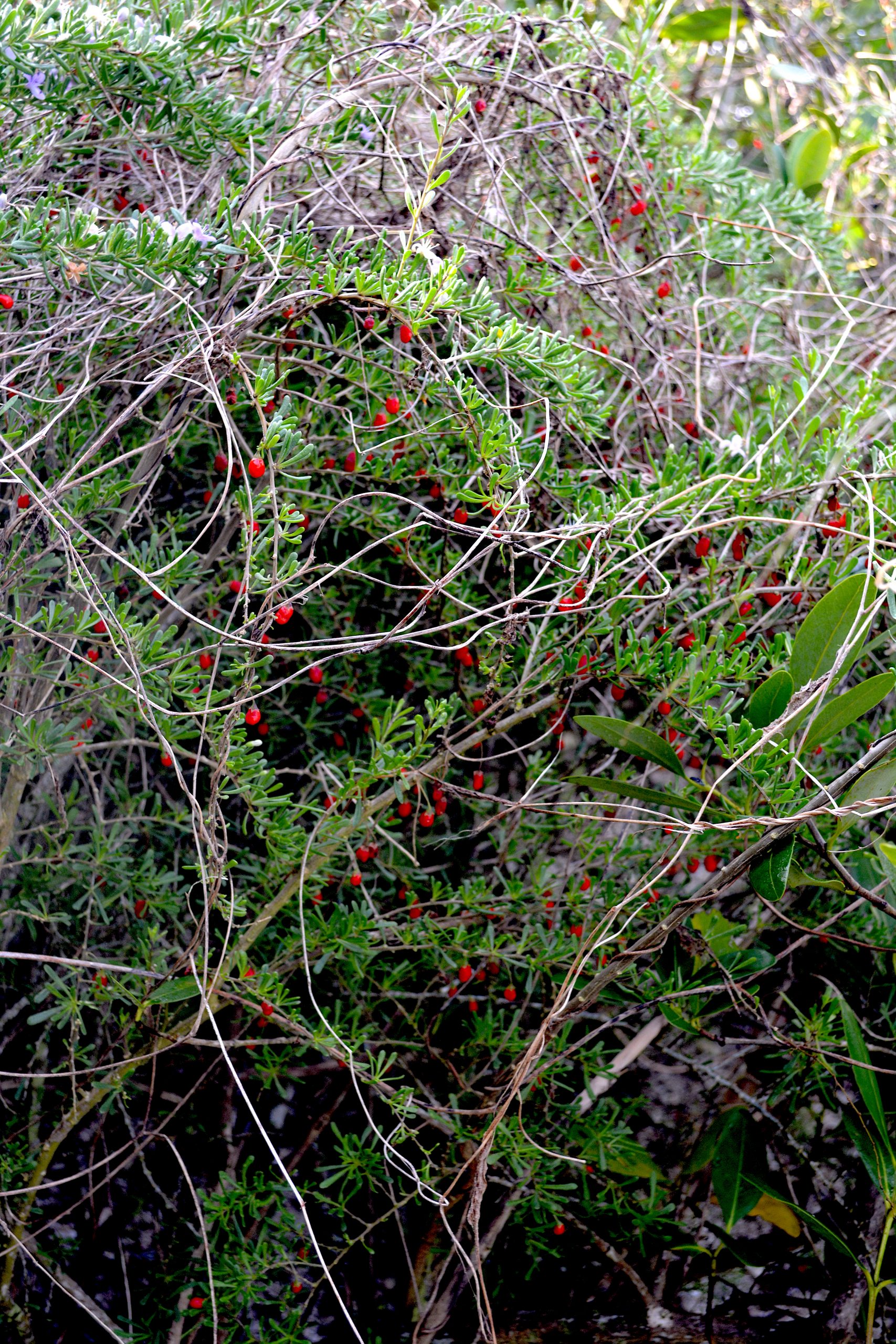
Goji berries like brackish water locations and the cooler weather of fall and winter. Photo by Green Deane
The Christmasberry, of which there are many, is poorly named. I have found it from late November to mid-April. We found and ate a lot of them in my foraging class last week south of Daytona Beach. I have also found patches barely blossoming to others fruiting heavily at the same time. Whenever you find Lycium carolinium its looks close to dead if not dying, dry, leafless, covered with Ramalina lichen. Except for the blossom it does not look like a member of the Nightshade family, which it is.
Most folks are surprised to learn Goji Berries grow in North America. Six species were eaten by Native Americans. Among the edibles species on this continent are L. andersonii, Lycium berlandieri, L. carolinianum, L. exsertum, L. fremontii, L. pallidum, and L. torreyi. L. ferocissimum is a pest in Australia and their native L. australe was eaten by the Aboriginals. The leaves of the L. halimifolium are cooked and eaten in Eurasia as is the L. chinense. The L. chinense and L. barbarum produce the commercial fruit called Goji Berry. L. barbarum is naturalized in England and L. chinense is naturalized in about 19 states and Ontario.
Interestingly the USDA nutrition panels on Goji Berries are unusually short, many of them commercially generated. According to the longest one 100 grams of dried Goji Berries have 349 calories, 14.26 grams of protein, 0.39 grams of fat, 77.06 grams of carbohydrates (45 of them sugar) and 13 grams of fiber. Vitamin C is 48.4 mg, two thirds your daily need, and vitamin A 26822 IU (which is some 11 times your daily need.) Sodium 298 mg, calcium 190 mg, and iron 6.8 mg. That is is high in sodium is not surprising. I always find the species growing where there is brackish water.
The species does come with some warmings. As mentioned the Goji is in the Nightshade family so perhaps people with an allergy to that family (tomatoes, peppers, egg plants, tomatillos et cetera) should avoid it. Goji is also high in lectins which can also bother people. The reason why we can’t eat raw kidney beans is lectins, the poison Ricin is lectins from the Castor Bean Plant. Lectins are carbohydrate-binding proteins. Cereal grains and legumes are high in lectins. Gluten is a lectin and some people are gluten intolerant. The one medical warning associated with Goji berries is they may increase the potency of drugs like Warfarin (making you bleed more easily.) Goji berries also contain atropine in low amounts
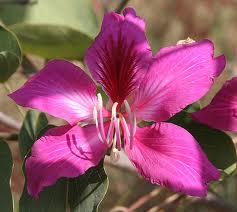
Bauhinia blossoms are edible but not all the seeds. Species vary.
We saw several species blooming this past weekend in my foraging class. The Hibiscus were happy including the “Sleepy Hibiscus.” It’s a fairly easy shrub to identify because the bright red blossoms that never unfurl. Also blossoming was the Bauhinia. It’s a tree that is both easy and challenging at the same time. The blossoms are edible, look nice in salads. Some of the species have edible seeds and some do not. (They are in the pea family and most pea trees — most not all — do not have edible seeds.) Sorting out which Bauhinia you have can be a challenge, nearly as bad as sorting out which Cereus you have. Like the Cereus cactus there are several man-made hybrids and perhaps even some fake botanical names. It can make species identification a real headache though as far as I know all the blossoms are edible. Only “discovered” 111 years ago the blossom of the Bauhinia blakeana is the emblem of Hong Kong. You can read about the Bauhinia here.
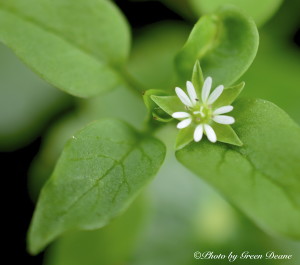
Chickweed is highly seasonal. Photo by Green Deane
Real chickweed will soon arrive. If you want to sample it in a variety of ways you have a couple of months at best. I usually find chickweed locally between Christmas and Valentine’s Day. It can be found earlier and occasionally after Valentine’s Day. But those two holidays mark the practical beginning and end of the local chickweed season. It also doesn’t grow much farther south than central Florida. In far northern climates Chickweed is a green of spring. It actually germinates under the snow so it can get a head start on other spring plants. Snow spits here every half century or so and the ground never freezes which is why we can forage 365 days a year. Early Chickweed in the Carolinas can be found Starting in September. Chickweed itself is fairly easy to identify. Besides tasting like corn silk it has a stretchy inner core and one line of hair that runs along the stem switching sides at each pair of leaves. Don’t confuse Chickweed for a local cousin the edible, Drymaria cordata. To read more about chickweed click here. Also coming on strong is Pellitory. To read about Pellitory again click here.
Most of us have been told eating apple seeds is dangerous. That is usually followed by “there was a man who ate a cup of apple seeds and died…”
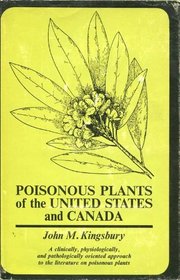 Is that theoretically possible? Yes. You’d have to eat 85 grams of apples seeds, about three ounces, or about 114 seeds, all at one time, all thoroughly chewed. That could, in theory, deliver a fatal dose of cyanide. That’s for a 150 pound person, a larger person could tolerate more, a child much less. Probably children should not eat any apple seeds. The way cyanide works is rather fascinating. It attaches to our red blood cells better than oxygen. So instead of oxygen being delivered throughout the body for mitochondrial use cyanide is. We essentially stop making energy. But what about the guy who ate the cup of seeds? There’s bit of a problem with that. In 1964 John Kingsbury, Phd., an expert on plant poisonings, particularly regarding farm animals, published Poisonous Plants of the United States and Canada, Prentice-Hall. He was the expert and his book became the book to reference. On page 365 Kingsbury wrote:
Is that theoretically possible? Yes. You’d have to eat 85 grams of apples seeds, about three ounces, or about 114 seeds, all at one time, all thoroughly chewed. That could, in theory, deliver a fatal dose of cyanide. That’s for a 150 pound person, a larger person could tolerate more, a child much less. Probably children should not eat any apple seeds. The way cyanide works is rather fascinating. It attaches to our red blood cells better than oxygen. So instead of oxygen being delivered throughout the body for mitochondrial use cyanide is. We essentially stop making energy. But what about the guy who ate the cup of seeds? There’s bit of a problem with that. In 1964 John Kingsbury, Phd., an expert on plant poisonings, particularly regarding farm animals, published Poisonous Plants of the United States and Canada, Prentice-Hall. He was the expert and his book became the book to reference. On page 365 Kingsbury wrote:
“Apple seeds are cyanogenetic. A man, who found apple seeds a delicacy, saved a cupful of them. Eating them at one time, he was killed by cyanide poisoning.”
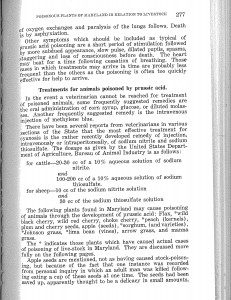 Kingsbury’s inclusion of the incident in his book gave the story legitimacy and it has been quoted extensively ever since by professionals and amateurs alike. But from a traditional journalistic point of view the story is full of what we called in the newsroom “holes.” Who ate the seeds, when, and where? Basic facts that add credibility. Professor that he was Kingsbury included where he got the story from in footnote 1335. That footnote reads: Reynard, G.B., and J.B.S. Norton in Poisonous Plants of Maryland in Relationship to Livestock. Maryland Agricultural Experimental Station, Technical Bulletin. A10, 1942. 312 pp. So Kingsbury in 1964 is quoting a farm bulletin from 1942. What does that bulletin say? On page 276 of the now 77-year old bulletin Reynard and Norton write about prussic acid harming livestock. (Amygdalin is essentially a sugar and cyanide molecule which when digested releases hydrogen cyanide which used to be called prussic acid.) They note in the last paragraph, above right:
Kingsbury’s inclusion of the incident in his book gave the story legitimacy and it has been quoted extensively ever since by professionals and amateurs alike. But from a traditional journalistic point of view the story is full of what we called in the newsroom “holes.” Who ate the seeds, when, and where? Basic facts that add credibility. Professor that he was Kingsbury included where he got the story from in footnote 1335. That footnote reads: Reynard, G.B., and J.B.S. Norton in Poisonous Plants of Maryland in Relationship to Livestock. Maryland Agricultural Experimental Station, Technical Bulletin. A10, 1942. 312 pp. So Kingsbury in 1964 is quoting a farm bulletin from 1942. What does that bulletin say? On page 276 of the now 77-year old bulletin Reynard and Norton write about prussic acid harming livestock. (Amygdalin is essentially a sugar and cyanide molecule which when digested releases hydrogen cyanide which used to be called prussic acid.) They note in the last paragraph, above right:
“Apple seeds are mentioned, not as having caused stock-poisoning, but because of the fact that one instance was recorded from personal inquiry in which an adult man was killed following eating a cup of these seeds at one time. The seeds had been saved up, apparently thought to be a delicacy in small amounts and upon being eaten developed enough of the deadly prussic acid to cause this tragic death. The instance is recorded here as a caution to others who might attempt to eat more than a few of these seeds at any one time. Previous investigators have reported that apple seeds contain appreciable amounts of amygdalin from which prussic acid is developed, but actual reports of poisoning are rare.”
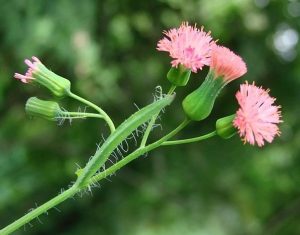
Florida Tasselflower is long-term toxic to humans and very toxic for horses.
Livestock poisonings from prussic acid are “rare.” What of humans? A 130-year search of the New York Times by this writer produced 437 stories involving prussic acid. Those included suicides, murders and a few accidental medicinal deaths. None by an apple seed overdose (which surely would have made the newspaper.) We are left with no who, no where, and no when as well as a “recorded from personal inquiry…” and “apparently.” That means someone told them it had happened. Their reference is as weak as Kingsbury’s. Without a name, a time and place it is not much better than an urban legend. It could have happened, or it just might be a story. More so, man has been eating apples for some 6,000 years. One would have thought in that amount of time it would have become common knowledge that you don’t eat a lot of apple seeds in one sitting. Also during the days of Johnny Appleseed everyone was making cider and there were millions of seeds available annually for decades if not centuries. One wouldn’t have to save them up at all. Getting rid of apple seeds was a problem, not getting enough of them. Also they dry out very quickly so if you saved only a few at at time by the time you had a cup that way the earlier seeds would not be edible (and drying can reduce the offending chemical. My grandmother dried peach pits for that purpose, making them safe.) And … with all those millions of seeds around and hungry people why only one report of an apple seed over dose?
We can’t say the story is not true, but we can call it doubtful. Click here to read about Wild Apples.
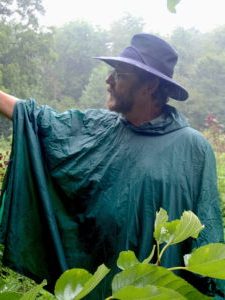
Classes are held rain or shine or cold. (Hurricanes are an exception.) Photo by Kelly Fagan.
Foraging Classes: Two favored locations for classes this weekend, Port Charlotte and Mead Garden. The Saturday class in Port Charlotte is filling up quickly. It features a variety of edibles including many salt-tolerant species. Mead Garden Sunday is a central location with a great diversity of species.
Saturday December 4th, Bayshore Live Oak Park, Bayshore Drive. Port Charlotte. 9 a.m. to noon. Meet at the parking lot of Bayshore and Ganyard St.
Sunday December 5th, Mead Garden: 1500 S. Denning Dr., Winter Park, FL 32789. 9 a.m. to noon. Meet at the bathrooms. The park entrance is on South Denning. Some GPS directions get it wrong.
Saturday December 11th, Red Bug Slough Preserve, 5200 Beneva Road, Sarasota, FL, 34233. 9 a.m. to noon. Meet by the playground.
Sunday December 12th, Blanchard Park, 10501 Jay Blanchard Trail, Orlando, FL 32817. 9 a.m to noon, meet at the pavilion next to the tennis courts.
Updating videos: This past month was busy with the uploading of 12 new videos on You Tube in EatTheWeeds: 151: Persimmon Revisited, 152: Lantana, 153: Sea Oxeye, 154: Tropical Almond Revisited, 155: Sumac Revisited, 156: Seagrapes, 157: Tamarind, 158: Bananas Revisited, 159: Ghost Pipes, 160: Swine Cress, 161: Goldenrod, and 162 Dove Plum. The goal over the coming months is to revisit some species that were recorded on old technology. Some new species will be as well.
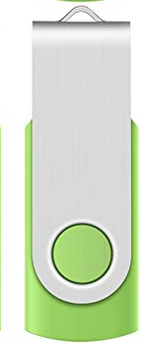
Green Deane videos are now available on a USB.
My nine-DVD set of 135 videos has been phased out and replaced by a 150-video USB. The USB videos are the same videos I have on You Tube. Some people like to have their own copy. The USB videos have to be copied to your computer to play. If you want to order the USB go to the DVD/USB order button on the top right of this page or click here. That will take you to an order form. I’d like to thank all of you who ordered the DVD set over the years which required me to burn over 5,000 DVDs individually.

Green Deane Forum
Want to identify a plant? Perhaps you’re looking for a foraging reference? You might have a UFO, an Unidentified Flowering Object, you want identified. On the Green Deane Forum we — including Green Deane and others from around the world — chat about foraging all year. And it’s not just about warm-weather plants or just North American flora. Many nations share common weeds so there’s a lot to talk about, such as the one to the left. There’s also more than weeds. The reference section has information for foraging around the world. There are also articles on food preservation, and forgotten skills from making bows to fermenting food. Recent topics include: California Wild Mushroom Parties, A Good Reason To Eat Wild Garlic, Black Walnuts and Amaranth, Sea Salt and Plastic, Wild Mustard? Heavy Metals. Oriental Persimmons. What is it? Pine Cough Drops and Needles, Skullcap, Malodorous Plant? Another NJ Tree, Maypop? Roadside Plant, Unknown in Sudan, Please Help Identify, and Preserving Prickly Pear Bounty. You can join the forum by clicking on the button on the upper right hand side of this page.
My annual Urban Crawl is coming up, my twelfth, on Friday, December 17th. We meet in front of Panera’s at 10 a.m. in Winter Park (north end of Park Avenue.) We wander south to Rollins College, head back north stopping at Starbucks to drink & drain, go east to the public library area, the lake docks, then back to Panera’s. It takes a couple of hours. There is a free parking garage behind (west) of Paneras if you go to the upper floors. If you park on the city streets you chance a ticket as the class is longer than parking hours allow.


My father (a child of the Great Depression) always completely ate his apples -no core left. I’m older now and doing the same thing. No poisoning yet-(Mitzi)
In the above article on whether or not apple seeds killed a man, there was a random picture of “Florida tasselflower” claiming it’s toxic. The Florida tasselflower has bright red flowers. (www.wildsouthflorida.com)
I believe what is pictured above is the Lilac tasselflower which has several uses and is yummy in salads. Please clarify.
There are two species in question: Emilia fosbergii and E. sonchifolia. Both have pyrrolizidine alkaloids. You might want to read: https://www.sciencedirect.com/science/article/abs/pii/S0889157515000782 and https://www.sciencedirect.com/science/article/pii/S0305197820300843
Ok. Thank you. 🙂